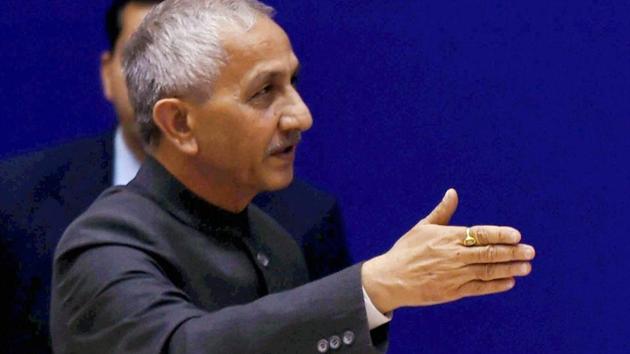There is no one ‘Kashmir problem’; and there cannot be a silver bullet solution
There has been a habitual muddling of issues, and an extraordinary neglect of context and trends. Crucially, there is not just one Kashmir problem, but many, and each requires redress by divergent means and at different stages.
A flurry of commentary has followed the appointment of former director of the Intelligence Bureau Dineshwar Sharma, as the Centre’s representative (the title ‘interlocutor’ was studiously avoided) to “initiate and carry forward a dialogue” in Jammu & Kashmir (J&K). Detractors have seized upon this as an admission that the Centre’s ‘muscular’ policy, or ‘Doval doctrine’ has failed. Others insist that the appointment of a former DIB will be counterproductive, as a ‘political initiative’ is what was needed. It is argued that given Sharma’s background, his appointment suggests a continuation of an enforcement-dominated approach; or, further, that unless Sharma also talks to Pakistan, the process will be infructuous.

The broad contours of the conflict in J&K find little space in this commentary. Sharma’s appointment, it would seem, stands alone and is to be judged on its potential to ‘solve’ the Kashmir problem – on which impossible criterion we can safely declare it a failure at once.
There is, in this commentary, a habitual muddling of issues, and an extraordinary neglect of context and trends. Crucially, there is not just one Kashmir problem, but many, and each requires redress by divergent means and at different stages. The most urgent is the problem of terrorism and the bloodshed and disruption it generates. This has periodically been compounded by organised street violence. Then there are the more enduring and manifold problems of governance and of a communal, polarising and disruptive politics; and, of course, underlying all these is the canker of Pakistan .
No regime in India, including the present one, has ever suggested that the military approach alone is to be applied to J&K. Had that been the case, the state would simply have been brought under President’s rule and handed over to the Army. To borrow the stock clichés of the bureaucracy, the solutions proposed are always intended to be ‘holistic’ and ‘multi-pronged’. Indeed, for those who argue that Pakistan must be brought into the dialogue process for any concrete progress to be made, it is useful to recall not only the numberless cycles of past talks with Islamabad. Now, the Prime Minister has declared that it was not ‘goli ya gali’ (the bullet or abuse), but ‘embracing all Kashmiris’ that would produce a solution.
Advocates of ‘dialogue’ glibly ignore the many failures of their favoured policy, but are eager to seize upon purported failures of ‘muscular’ responses. It is useful, consequently, to review the trajectory of violence in J&K to see how this has worked. First, the long term trend: J&K experienced 17 years of high intensity conflict (over 1,000 fatalities a year) between 1990 and 2006 (all data from the South Asia Terrorism Portal), peaking at 4,507 killed in 2001. From this peak, the trajectory was consistently downwards till 2012, when fatalities fell to 117. No dramatic shifts in India’s policy or strategy are noticeable during this period of sustained improvement. It was principally growing international and domestic pressure on Pakistan, and a shift in Islamabad’s priorities towards its mischief in Afghanistan that resulted in a de-escalation in J&K. Pakistan’s willingness to enter into a ceasefire agreement with India in 2003, and to maintain its terms almost without violation through the Pervez Musharraf regime till 2008, contributed significantly to this downtrend.
Significantly, the uptrend in violence commenced in 2013 (181 fatalities), before the Modi regime was established in Delhi, or the PDP-BJP combine in J&K. The present ‘muscular’ policy dates back to the Burhan Wani killing in July 2016, and the ensuing stone pelting campaign, taking terrorism-linked fatalities up to 267 in 2016 and 290 in 2017 (till October 22).
Around 61% of all fatalities in 2017 are terrorists, and among these are top field commanders of all active terrorist formations in the state. The distribution of this violence is crucial: 14 of J&K’s 22 districts account for all the fatalities; on a further breakdown to the tehsil level, just 32 of 82 tehsils recorded fatalities. Crucially, the worst five tehsils accounted for 48% of all fatalities.
Terrorist and separatist violence in J&K has been severely circumscribed, and is overwhelmingly localised to small and shrinking extremist-dominated constituencies, principally along the Line of Control (LoC). A bulk of terrorist fatalities is recorded along the LoC, and principally comprises fresh infiltrators. It is the success of kinetic measures that has opened up spaces for the revival of a dialogue process. Memories are short, and most commentators appear to have forgotten that an all-party delegation of members of Parliament to J&K in September 2016 saw separatist leaders slamming their doors in their faces.
Sharma’s task is to create grounds for the resumption of dialogue at the political level, and it cannot be bound by irrational timelines and expectations. As kinetic pressures mount, he will engage with those who show themselves willing to abjure violence. He offers a window of escape, not a magical solution.
Ajai Sahni is executive director, Institute for Conflict Management, New Delhi
The views expressed are personal



